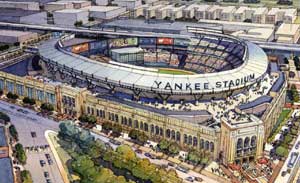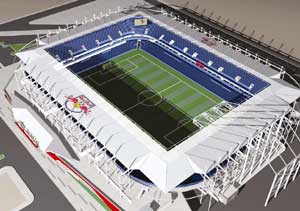As professional sports teams in dozens of markets around the nation built 63 new stadiums and arenas since 1990, the New York metropolitan area stuck to its aging facilities � until now. But the sudden surge of projects raises capacity questions.


New York sports fans have been living in the past.
While baseball fans across the country have been treated to trendy new stadiums over the last 15 years, Yankees and Mets fans have continued to watch paint peel at their aging, outdated ballparks.
As state-of-the-art venues popped up around the National Football League, Jets and Giants faithful have filled the no-frills, three decades-old Giants Stadium every autumn Sunday. And basketball and hockey fans in New York and New Jersey haven’t seen a new big-league venue since the Brendan Byrne Arena, now Continental Airlines Arena, opened in East Rutherford, N.J., in 1981.
But the tide is changing. Stadium and arena projects worth nearly $3 billion are currently under construction in the New York City metropolitan area, and another $1 billion is under consideration.
Work is well under way on the new $800 million Yankee Stadium in the Bronx and the $600 million Citi Field for the Mets in Queens, both of which are expected to open in 2009. Work also began on a new $1.4 billion home for the Jets and Giants this summer at the Meadowlands Sports Complex in East Rutherford.
Meanwhile, the $375 million, 800,000-sq-ft Prudential Center is set to open this fall in Newark to house hockey’s New Jersey Devils and Division 1 NCAA basketball for the Seton Hall University Pirates, both of which will vacate the Continental arena at the Meadowlands complex.
Work may also soon start on a $435 million arena in Brooklyn that is intended to house the National Basketball Association’s Nets franchise, which also plays in the Continental arena. The new venue, designed by Frank Gehry of Los Angeles, would be part of the $4 billion Atlantic Yards development that Brooklyn’s Forest City Ratner is aiming to start this year.
Even Major League Soccer is in on the act planning the region’s first soccer-only venue in Harrison, N.J., a new $130 million stadium for the New York Red Bulls.
“This is unprecedented,” says Dan Doctoroff, New York City’s deputy mayor for economic development and rebuilding. “[Metro] New York sort of missed [the recent stadium boom] the first time around... In the next four years, we’ll have six new facilities.”
One question that arises, with all of the stadium and arena activity coming together at once, is whether the construction industry has capacity to absorb the work – especially when the market is also booming in other sectors.
“The capacity of the contractors will be an issue as these projects move forward,” says Lou Coletti, president of the Building Trades Employers’ Association of New York. “When you put these major sports venue projects together with the rest of the market, that’s a problem.”
Planning Beyond the Sports Purpose
The stadium and arena projects now under development all have individual roots but common elements as well. For instance, several follow previous failed bids.
As far back as the early 1990s, the Yankees made various announcements about the team’s desire to have a new stadium, though the earlier search included the possibilities of moving to Manhattan or New Jersey. The Jets made a high-profile bid in 2004 to construct a $2.2 billion football stadium on Manhattan’s West Side that ultimately failed a year later because of opposition from state legislators.
“Stadiums always take years to get off the ground,” says Neil DeMause, a New York sports business writer. “[Former N.Y.C. Mayor Rudy] Giuliani ended up laying the groundwork, while [current Mayor Michael] Bloomberg will get his name on the plaques.”

Post a comment to this article
Report Abusive Comment